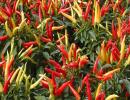 |
Peppers
Scientific name:
Capsicum spp. (C. annuum, C. frutescens)
Family:
Solanales: Solanaceae
Local names:
Pilipili (Swahili)
Common names:
Sweet pepper, Bell pepper, Chilli, Hot pepper
Pests and Diseases: African bollworm
Anthracnose
Aphids
Bacterial soft rot
Bacterial spot
Bacterial wilt
Broad or yellow tea mite
Broomrape
Cercospora leaf spot
Collar rot
Cutworms
Damping-off diseases
Dodder
Fruit flies
Fusarium wilt
Leafmining flies (leafminers)
Phytophthora blight
Powdery mildew
Root-knot nematodes
Sedges
Spider mites
Thrips
Viral diseases
Whiteflies
|
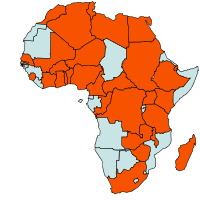 |
| Geographical Distribution of Peppers in Africa |
Nutritive Value per 100 g of edible Portion
| Raw or Cooked Pepper | Food Energy (Calories / %Daily Value*) |
Carbohydrates (g / %DV) |
Fat (g / %DV) |
Protein (g / %DV) |
Calcium (g / %DV) |
Phosphorus (mg / %DV) |
Iron (mg / %DV) |
Potassium (mg / %DV) |
Vitamin A (I.U) |
Vitamin C (I.U) |
Vitamin B 6 (I.U) |
Vitamin B 12 (I.U) |
Thiamine (mg / %DV) |
Riboflavin (mg / %DV) |
Ash (g / %DV) |
| Ancho Pepper dried | 281 / 14% | 51.4 / 17% | 8.2 / 13% | 11.9 / 24% | 61.0 / 6% | 201 / 20% | 10.9 / 61% | 2411 / 69% | 20439 IU / 409% | 2.0 / 3% | 3.5 / 177% | 0.0 / 0% | 0.2 / 12% | 2.3 / 133% | 5.9 |
| Banana Pepper raw | 27.0 / 1% | 5.3 / 2% | 0.5 / 1% | 1.7 / 3% | 14.0 / 1% | 32.0 / 3% | 0.5 / 3% | 256 / 7% | 340 IU / 7% | 82.7 / 138% | 0.4 / 18% | 0.0 / 0% | 0.1 / 5% | 0.1 / 3% | 0.7 |
| Serrano Pepper raw | 32.0 / 2% | 7.5 / 3% | 0.4 / 1% | 1.7 / 3% | 11.0 / 1% | 40.0 / 4% | 0.9 / 5% | 305 / 9% | 937 / 19% | 44.9 / 75% | 0.5 / 25% | 0.0 / 0% | 0.1 / 4% | 0.1 / 5% | 0.9 |
| Green Hot Chili Peppers raw | 40.0 / 2% | 9.5 / 3% | 0.2 / 0% | 2.0 / 4% | 18.0 / 2% | 46.0 / 5% | 1.2 / 7% | 340 / 10% | 1179 IU / 24% | 242 / 404% | 0.3 / 14% | 0.0 / 0% | 0.1 / 6% | 0.0 / 0% | 0.6 |
| Red Hot Chili Pepper raw | 40.0 / 2% | 8.8 / 3% | 0.4 / 1% | 1.9 / 4% | 14.0 / 1% | 43.0 / 4% | 1.0 / 6% | 322.0 / 9% | 952 IU / 19% | 144 / 239% | 0.5 / 25% | 0.0 / 0% | 0.1 / 5% | 0.0 / 0% | 0.9 |
| Jalapeno Peppers raw | 30.0 / 2% | 6.3 / 2% | 0.6 / 1% | 1.3 / 3% | 10.0 / 1% | 31.0 / 3% | 0.7 / 4% | 215.0 / 6% | 799 IU / 16% | 44.3 / 74% | 0.5 / 25% | 0.0 / 0% | 0.1 / 10% | 0.1 / 3% | 0.4 |
| Sweet Green Peppers cooked | 28.0 / 1% | 6.7 / 2% | 0.2 / 0% | 0.9 / 2% | 9.0 / 1% | 18.0 / 2% | 0.5 / 3% | 166.0 / 5% | 468 IU / 9% | 74.4 / 124% | 0.2 / 12% | 0.0 / 0% | 0.1 / 4% | 0.0 / 2% | 0.3 |
| Sweet Green Pepper raw | 20.0 / 1% | 4.6 / 2% | 0.2 / 0% | 0.9 / 2% | 10.0 / 1% | 20.0 / 2% | 0.3 / 2% | 175 / 5% | 370 IU / 7% | 80.4 / 134% | 0.2 / 11% | 0.0 / 0% | 0.1 / 4% | 0.0 / 2% | 0.4 |
| Sweet Red Pepper cooked | 28.0 / 1% | 6.7 / 2% | 0.2 / 0% | 0.9 / 2% | 9.0 / 0% | 18.0 / 2% | 0.5 / 3% | 166.0 / 5% | 2941 IU / 59% | 171 / 285% | 0.2 / 12% | 0.0 / 0% | 0.1 / 4% | 0.0 / 2% | 0.3 |
| Sweet Red Pepper raw | 31.0 / 2% | 6.3 / 2% | 0.3 / 0% | 1.0 / 2% | 7.0 / 1% | 26.0 / 3% | 0.4 / 2% | 211.0 / 6% | 3131 IU / 63% | 128.0 / 213% | 0.3 / 15% | 0.0 / 0% | 0.1 / 4% | 0.1 / 5% | 0.5 |
| Sweet Yellow Pepper raw | 27.0 / 1% | 6.3 / 2% | 0.2 / 0% | 1.0 / 2% | 11.0 / 1% | 24.0 / 2% | 0.5 / 3% | 212.0 / 6% | 200 IU / 4% | 183 / 306% | 0.2 / 8% | 0.0 / 0% | 0.0 / 2% | 0.0 / 1% | 0.5 |
For information on hot-water treatment of seeds click here.
Seedbeds are usually covered with straw, leaves or protective tunnels. For better production, seedlings should be transferred to seedling pots (plastic pots, paper cups, banana leaf-rolls, etc.) when the cotyledons are fully expanded. Transplants are planted out in the field at the 8-10 true leaf stage, usually 30-40 days after sowing. Hardy transplants can be produced by restricting water and removing shade protection, starting 4-7 days before transplanting. Transplanting should be done during cloudy days or in the late afternoon, and should be followed immediately by irrigation. Direct sowing in the field is practised to a limited extent. Capsicum peppers are well adapted to sole cropping and intercropping systems. Capsicum peppers are often relay-cropped with tomatoes, shallots, onions, garlic, okra, Brassica spp. and pulses. They also grow well among newly established perennial crops.
Cultivars commonly grown in Kenya:
Sweet pepper (C. annuum):
- California Wonder
- Yolo wonder
- Emerald Giant
- Ruby Giant
Hot pepper (C. frutescens):
- Anaheim
- Fresno
- Jalapeno
- Long Red Cayenne
- Rocket
- Short Bullet
Damping-off and root rot (Rhizoctonia solani / Pythium spp. / Fusarium spp.
Seedlings fail to emerge (pre-emergence damping-off); small seedlings collapse (post-emergence damping-off); seedlings are stunted through root rot and / or collar rot. Nursery beds show irregular patches. The fungi causing seedling diseases are soil inhabitants. Pythium spp. are favoured by low temperatures while R. solani and Fusarium spp. thrive at higher temperatures.
- Plant certified disease-free seed.
- Nursery beds should be located on well drained sites not previously under vegetable production.
- Proper watering regime.
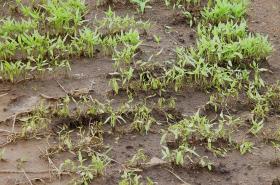
Damping-off disease in chilli field
© A. A. Seif & B. Nyambo, icipe
Powdery mildew (Leveillula taurica)
Yellowish blotches or spots appear on the upper leaf surface. The leaf surface is covered with a white to grey powdery fungal growth. The disease progresses from the older to younger leaves and shedding of the foliage is pronounced. Leaf defoliation leads to reduction in size and number of fruits. It also results in fruits being sun-burned. The disease is favoured by warm, humid and dry weather. The fungus causing powdery mildew also attacks eggplants and tomatoes. Overhead irrigation reduces disease severity.
- Plant resistant cultivars, if available.
- Apply sulphur based fungicides at the onset of disease symptoms.
- Remove and destroy crop debris after harvest.
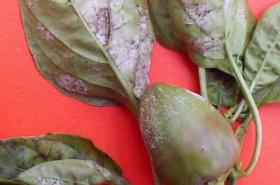
Powdery mildew on leaves and fruit of chilli. Note fungal growth on pod.
© A. A. Seif & B. Nyambo, icipe
Anthracnose (ripe rot) (Colletotrichum capsici)
Anthracnose caused by Colletotrichum spp. is a major problem of ripened fruits. The fungus produces dark, sunken spots up to 2.5 cm across on sweet pepper. The spots occur on green and ripe fruits and their surface may be covered in moist weather with salmon-pink mass of spores. The fungus is seed-borne.
- Use certified disease-free seeds.
- Hot water treat own produced seeds. For more information on hot water treatment click here
- Practise field sanitation (removal of crop debris after harvest).
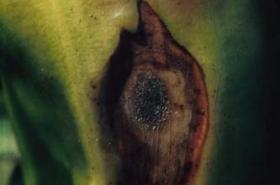
Anthracnose (Colletotrichum capsici) on sweet pepper (Capsicum annuum)
© © Courtesy EcoPort (http://www.ecoport.org): J. Kranz
Viral diseases
About 17 viruses have been reported to attack peppers. Those considered economically important in Africa include alfalfa mosaic, chilli veinal mottle, cucumber mosaic, pepper veinal mottle, potato Y, tobacco etch, tobacco mosaic, tomato spotted wilt and chilli leaf curl.
Most of these viruses are transmitted by insects, infected seed and a few by mechanical means. The first six above listed viruses are spread by aphids; tobacco mosaic is mechanically transmitted and infected seed; tomato spotted wilt by thrips; and chilli leaf curl by whiteflies.
Viral diseases are particularly difficult to firmly diagnose by symptoms because there is so much overlap in symptomatology. Furthermore, symptom expression can be altered by many factors among which are cultivar, age of host plant, environmental conditions, host plant nutrition, and viral strains, not to mention the occurrence of virus mixtures. General symptoms include mosaic patterns on leaves, yellowing , ring spots, leaf deformation or distortion, curling of leaves, and/or stunting of plants. They may also cause reduction of fruit size, distortion, and/or ring patterns.
- Plant resistant cultivars, if available.
- Select planting dates to avoid high population of vectors.
- Close plant spacing to compensate for diseased plants.
- Use barrier crops to minimise virus spread.
- Use oil sprays to reduce virus transmission by aphids.
- Use reflective mulches to repel aphids and thrips. For more information on mulching click here.
- Use certified disease-free seed in case of tobacco mosaic virus.
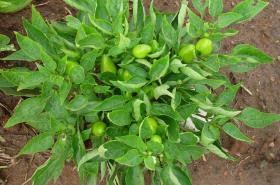
Chilli plant affected by a virus disease
© A. A. Seif, & B. Nyambo, icipe
Bacterial soft rot (Erwinia carotovora pv. carotovora)
Soft rot often begins in the peduncle and calyx tissues of harvested fruit. Infection can occur through wounds anywhere on the fruit. Fruit infected on the plant collapses and hangs on the plant like a water-filled bag. When the contents leak out, a dry shell of the fruit remains.
The bacteria are soil-borne. Soft rot is primarily a post-harvest problem although it can occur in the field being facilitated by injuries to the fruit by insects and water splash. The disease is serious during rainy periods because the bacteria are splashed from the soil onto the fruit, which are more susceptible due to their high moisture content.
- Rotation with beans or maize.
- Control of insects that cause injury to fruits.
- Post-harvest decay can be reduced by harvesting fruits when dry, minimising injury during handling, and store at cool temperatures.
- ]If fruits must be washed, add free chlorine in the wash water to eliminate soft-rot bacteria. However, this treatment prevents infection during washing but does not prevent soft rot development in fruits that were already infected before washing.
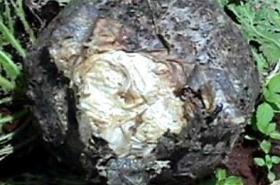
Bacterial soft rot. Note slimy rot (whitish) of the centre of the cabbage head
© A. M. Varela, icipe
Bacterial spot (Xanthomonas campestris pv. vesicatoria)
Leaves, fruit and stems can be attacked by the disease. Leaf spots begin as circular, water-soaked that become necrotic with brown centres surrounded by yellowish borders. The spots are sunken on the upper leaf surface and slightly raised on the lower surface. On stems spots are elongated. Affected leaves turn yellow and drop. Affected fruits have raised brown spots that are wart-like in appearance. The disease has a wide distribution wherever peppers are grown. It spreads rapidly during warm, rainy conditions. High relative humidity with free moisture on leaves for long periods favours infection. Ideal temperatures for infection are above 20° C. The bacterium is seed-borne and survives in crop debris.
- Use of resistant varieties, if available.
- Use certified disease-free seed.
- Crop rotation.
- Copper sprays can reduce the rate of disease development.

Bacterial spot of pepper ((Xanthomonas campestris pv. vesicatoria))
© Courtesy EcoPort (http://www.ecoport.org): Volcani Center Archives, Bet Dagan, Israel, www.insectimages.org
Bacterial wilt (Ralstonia solanacearum)
The disease occurs in scattered plants or groups of plants in the field. Characteristic symptom is wilting of the entire plant with no leaf yellowing. Cross sections cut from roots and lower stems of diseased plants exude milky streams of bacteria from the vascular system when suspended in water. The bacteria have a wide host range and can survive in the soil for long periods.
The disease is favoured by wet, warm conditions. Peppers are not as susceptible as eggplants, potatoes, tobacco or tomatoes. Rotation is not effective as the pathogen can survive for a long period - several years - in the soil and also attack a wide range of crops and solanaceous weeds.
- Plant varieties that are tolerant / resistant, if available.
- Do not grow peppers in soil where bacterial wilt has occurred.
- Remove wilted plants from the field to reduce spread of the disease from plant to plant.
- Control root-knot nematodes since they could facilitate infection and spread of bacterial wilt.
- Soil amendments (organic manures) can suppress bacterial wilt pathogen in the soil.
- Rotation is of limited value since the disease has a wide host range, but still it is recommended to avoid continuous planting of solanaceous crops.
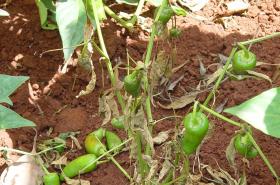
Bacterial wilt (Ralstonia solanacearum) on sweet pepper
© A.M. Varela, icipe

Bacterial …

Bacterial …

Bacterial …
Cercospora leaf spot (Frogeye) (Cercospora capsici)
Spots on leaves are brown and circular with small to large light grey centres and dark brown margins. Spots on stems, petioles and peduncles are typically elliptical and also have light grey centres with dark borders. Infected leaves are shed. Extensive defoliation occurs under severe disease pressure. Fruits are not attacked. The fungus survives on seeds and in crop debris. The disease is favoured by prolonged periods of wetness.
- Plant resistant cultivars, if available.
- Use certified disease-free seeds.
- Practise good field sanitation.
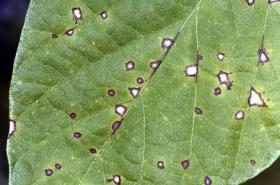
Cercospora leaf spot on soybean
© Courtesy EcoPort (http://www.ecoport.org): Clemson University, USDA
Collar rot (Sclerotium rolfsii)
It is a common and destructive disease of peppers widespread in the tropics. The fungus attacks the stem at ground level eventually girdling and killing it. White fungal growth usually is visible on the base of the stem and on the soil line around the base of the plant. On the white fungal mat, sclerotia (resting fungal spores) about the size of mustard seed that are tan to brown when mature are produced. High soil moisture and temperatures (30-35° C) favour disease development. Symptoms are more severe during dry conditions following a wet period. The fungus has an extremely broad host range and it is also a good saprophyte.
- The disease can be reduced by liming and deep ploughing
Fusarium wilt (Fusarium oxysporum f.sp. capsici)
Disease symptoms include drooping and yellowing of lower leaves followed by wilting of the entire plant. Leaves on infected plants remain attached and the vascular system of the plant is discoloured, particularly in the lower stem and roots. The fungus lives indefinitely in the soil and is spread in irrigation water. It is very susceptible to changes in temperature and soil moisture. The optimum temperature for disease development is 24 to 27° C.
Soil moisture has the greatest influence. The wilt does not occur in dry soil, but it is serious in poorly drained fields.
- Plant resistant cultivars, if available.
- Lime the soil.
- Ensure the soil has a good drainage.
- Apply soil antagonist Trichoderma spp., which is commercially available in Kenya.
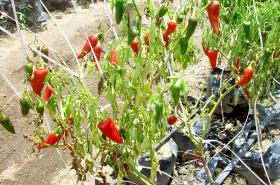
Chili plant infected with fusarium wilt (Fusarium oxysporum f.sp. capsici).
© A.A. Seif & B. Nyambo, icipe

Fusarium w…

Fusarium w…

Fusarium w…
Phytophthora blight (Phytophthora capsici)
All parts of the pepper plant can be affected. Seedlings can be killed. Collar rot and wilt phase is most common and is characterised by a dark brown stem discolouration extending upward from the soil line accompanied by a sudden wilt of the entire plant. Upper stem lesions (spots) are also dark brown and occur primarily at branch points causing death of branches above the lesions. Leaf spots are round or irregularly shaped, dark green and water-soaked. They later dry and become light tan.
Fruit infection begins as water-soaked, dull green spots that expand rapidly to cover the entire fruit. Later the fruits become flaccid and wrinkled but do not detach from the affected plants. The host range of the fungus includes cucurbits, eggplants and tomatoes. The fungus can survive on and in seeds, in soil and in crop debris. The collar rot and wilt phase is most severe in over-irrigated or poorly drained fields. Aboveground infection is associated with extended periods of rainfall or overhead irrigation.
- Plant resistant cultivars, if available.
- Use certified disease-free seeds.
- Grow on elevated beds.
- Practise good water management.
- Practise crop rotation (avoid in the rotation crops such as cucurbits, eggplant and tomatoes).
- Remove and destroy crop debris after harvest.
- Copper sprays can minimise disease losses.
Root-knot nematodes (Meloidogyne spp.)
Symptoms of infestation by root-knot nematodes are similar in all crops: wilting of plants and if infested plants are pulled from the soil the roots can be seen to be distorted, swollen and bearing knots (galls). The galls on pepper are much smaller than those on cucurbits or tomatoes. The infested roots eventually rot and affected plants die.
- Use of resistant varieties.
- Crop rotation.
- Mixed cropping with African marigold (Tagetes spp.).
- Maintaining high levels of organic matter in the soil (manure or compost). For more information on compost click here.
- Presently, some bioproducts are available for control of the root-knot nematodes (e.g. neem extracts). For more information on neem click here.
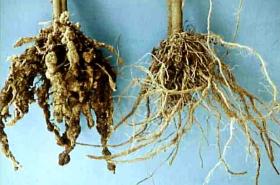
Root-knot nematodes (Meloidogyne incognita / M. javanica) Roots of severely attacked (left) and healthy plant (right). Affected plants are normally stunted and eventually wilt and die. The most characteristic symptom is formation of root galls (knots) and these can be seen with the naked eye. Affected roots rot.
© A. M. Varela, icipe
Spider mites (Tetranychus spp.)
Spider mites suck the sap of the plants, causing mottling of the upper leaf surface. Infested leaves first show a white to yellowing speckling, and then eventually turn bronze and fall off as the infestation becomes heavy. Spider mites prefer the lower surface of the leaves, but in severe infestations occur on both leaf surfaces as well as on stems and fruits. High infestations cause defoliation.
- Field hygiene is important for the management of spider mites. Old crops or weeds infested with mites can cause infestation of any new crop.
- Natural enemies such as predatory mites are important for control of spider mites.
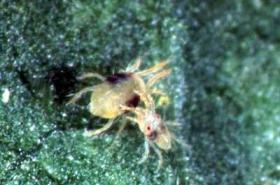
Two-spotted spider mite (Tetranychus urticae). The adult female is 0.6 mm long. The male is smaller.
© Warwick HRI, University of Warwick.
Aphids (Aphis gossypii, Myzus persicae)
Aphids (cotton aphid and green peach aphid) occur in colonies initially around tender plant parts (growing points, young stems and leaves, flower buds) and on the lower leaf surface. When numerous they can be found on all above ground parts of the plant. Aphids damage plants in three ways: by sucking their sap, excreting a sticky substance (honeydew) that coats the plants, or/and by transmitting viral diseases.
Feeding by aphids causes distortion (curling, wrinkling or cupping) of young leaves, chlorotic spotting and mottling of older leaves, and may lead to stunting and wilting of plants. Growth of sooty mould on honeydew excreted by aphids reduces photosynthesis and affects fruit quality.
Aphids cause indirect damage as vectors of important viruses such as alfalfa mosaic, chilli veinal mottle, cucumber mosaic, pepper mottle, pepper severe mosaic, pepper veinal mottle, potato Y and tobacco etch virus.
- Monitor regularly the crop.
- Aphids are naturally controlled by parasitic wasps; predators such as ladybird beetles, rove beetles, hoverflies, cecidomyiid flies, anthocorid bugs, spiders and lacewings; and by fungal diseases.
The parasitic wasps Aphidius spp are common in Kenya, and help to maintain aphids under control provided no broad-spectrum pesticides are used for control of aphids or other pests. - Whenever necessary spray only affected plants (spot spraying).Use biopesticides that are not harmful to natural enemies (for instance neem, ashes, soapy water).
- Neem products have a repellent effect and have been effective in reducing numbers of aphids on peppers when applied at 10 days intervals.
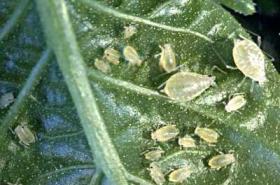
Green peach aphid (Myzus persicae) on a pepper leaf. Adult wingless females are oval-bodied, 1-2 mm in body length, of very variable colour.
© Magnus Gammelgaard
Cutworms (Agrotis spp., Spodoptera spp.)
Cutworms are the caterpillars of various moths, belonging mostly to the genus Agrotis. Young caterpillars feed on leaves making small holes. After few days they drop to the soil where they live until pupation. Caterpillars remain in the soil during the daytime coming out at night to feed. They cut stems of young seedlings at the level of the soil, killing them and affecting establishment of the crop. Some Spodoptera species, in particular S. littoralis act sometimes as cutworms.
Caterpillars, in particular under hot conditions, hide during the day in the soil around the base of the plants, and may cut them, especially seedlings, at the base of the stem. At night they climb into plants to feed.
- Eliminate weeds early, well before transplanting.
- Plough and harrow the field to expose cutworms to natural enemies and desiccation.
- Dig near damaged seedlings and destroy cutworms.
- Conserve natural enemies. Parasitic wasps and ants are important in natural control of cutworms.
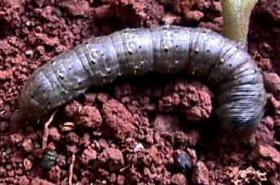
Cutworm (Agrotis sp.) Early instars are about 7-12 mm long. Fully grown caterpillars are 35-50 mm long.
© A.M. Varela, icipe
Fruit flies (Ceratitis spp., Bactrocera spp., Dacus spp.)
Fruit fly females lay eggs under the epidermis of the fruit. After emerging from eggs maggots generally move to the core to feed, but they may also feed on the walls of the fruit. This causes secondary rot and premature fruit fall. An infested fruit usually has a small dimple where the female fly deposited an egg. As the maggot matures inside the fruit, the fruits turn red prematurely, becoming soft and rotten.
Soft spots can often be seen where the maggot has fed on the fruit. When infested fruit is picked, the cap usually separates from the fruit because the maggot has eaten the core. Fruit may drop from the plant. Maggots remain in peppers until fully grown (from 2 to 3 weeks). At this time the maggot leaves the pepper, drops to the soil to pupate. Yield losses can be considerable. One maggot can destroy an entire fruit.
- Plough and harrow before planting. This exposes pupae in the soil to natural enemies and desiccation.
- Monitor fruit flies to determine when they arrive in the crop. Check the crop regularly and use bait traps.
- Collect and destroy damaged fruit.
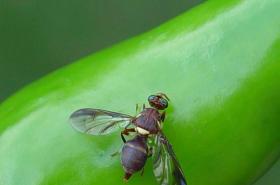
Fruit fly (Daccus bivittatus) on a chilli pod. Adults are 4-7mm long.
© A. M. Varela, icipe
Fruit borers (Helicoverpa spp.; Spodoptera spp.)
Moths of fruitborers are active at dusk and at night, feeding on nectar and laying eggs on leaves. Caterpillars feed on leaves, flowers and fruits. Although severe leaf damage by feeding of African bollworm (Helicoverpa spp.) caterpillars may slow plant growth due to reduced leaf area, caterpillar feeding on leaves is usually of not economic importance. The bollworms are about 2-3.5 cm long.
The main damage occurs on flowers and fruits. Attack on flower buds results in flower abortion. Caterpillars usually bore holes in fruits, causing extensive damage and promoting decay from secondary infection by diseases.
African armyworm (Spodoptera spp.) species are basically leaf-eaters and may cause defoliation when present in large numbers. They also feed on fruits, rendering them unmarketable.
- Plough the soil before planting. This exposes pupae to natural enemies and desiccation.
- Check the crop regularly. Early detection and destruction of eggs or young caterpillars before they bore into the fruits is very important.
- Hand pick and destroy damaged fruits, eggs and caterpillars. This helps when their numbers are low and in small fields.
- Conserve natural enemies. Parasitic wasps, ants, pirate bugs are very important for natural control of the African bollworm.
- Whenever necessary use biopesticides such as Bt, neem products or other plant extracts. This is particularly important from the onset of flowering. Target caterpillars before they enter the fruit. For more information on neem click here. For information on Bt click here.
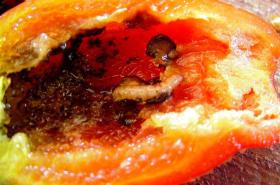
Anthracnose (Colletotrichum capsici) on sweet pepper (Capsicum annuum)
© © Courtesy EcoPort (http://www.ecoport.org): J. Kranz

Anthracnos…

Fruit bore…
Leafmining flies (Leafminers) Liriomyza spp.
Female flies make numerous small, whitish punctures on the foliage when feeding and depositing eggs. These punctures can serve as entry points for disease-causing organisms such as bacteria and fungi. The eggs hatch into tiny yellow maggots that feed on leaf tissues leaving a wandering track known as mines. Full-grown maggots come out of the mines to pupate in the soil beneath the plants or on the foliage. Maggots are the most destructive stage.
The mines may reduce photosynthetic activity, affecting development of flowers and fruits. In severe infestation, the leaves might be completely mined, dry and fall off prematurely, causing loss of vigour and turgidity of the plant. This may eventually result in wilting, in particular in warm weather, leading to yield loss, fruit sunscald, or in serious cases death of the plant, especially of young pants.
- Control by natural enemies is important.
- Ploughing can help in exposing pupae to desiccation and natural enemies.
- Neem products are effective for controlling leafminers. For more information on neem click here.
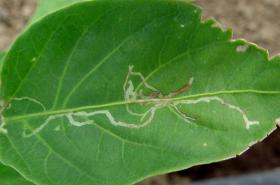
Mining of a chilli leaf by leafmining flies (Liriomyza spp.)
© A. A. Seif & B. Nyambo, icipe
Thrips (Frankliniella spp., Scirtothrips dorsalis, Thrips tabaci)
Thrips usually feed on all above ground parts of plants, preferring the underside of young leaves, flowers and fruits. Often they are concealed under the calyx. Plant damage results from thrips puncturing leaves and sucking the exuding sap. At the initial stage of infestation leaves have a silvery sheen and show small, dark spots of faecal material on the underside. When the attack increase leaves curl upward, wrinkle and finally dry up. This may predispose fruits to sunscald.
Heavy feeding damage turns leaves, buds and fruits bronze in colour. It may cause wilting, retardation of leaf development and distortion of young shoots resulting in stunted plants. Attack on fruits causes deformation and scarring (manifested as brown lines) of the fruits making them unmarketable, especially fruits for the export market. Thrips attack at the seedling and early stages of the crop delays crop development. Thrips transmit the tomato spotted wilt virus in peppers. S. dorsalis transmits the leaf curl disease of chillies.
- Natural enemies of thrips are important for natural control. Main natural enemies include anthocorid bugs (Orius spp.) predatory mites and spiders.
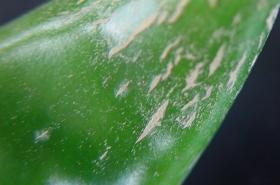
Thrips damage on a chilli pod.
© A.A. Seif & B. Nyambo, icipe

Thrips

Whiteflies (Bemisia tabaci, Trialeurodes vaporariorum)
Whiteflies damage plants in three ways. Whitefly immature stages (nymphs) and adults suck sap from leaves. Their feeding, in addition to removing plant nutrients, produces chlorotic spots on infested leaves. Nymphs excrete a clear sugary liquid known as honeydew, which often completely covers the leaves during heavy infestation. Honeydew supports the growth of a black sooty mould, and as a result the leaves may turn black, affecting photosynthesis.
Whiteflies are vector of important viral diseases such as chilli leaf curl, tiger disease, Serrano golden mosaic, and Texas pepper geminivirus.
- In areas where whitefly-transmitted viral diseases are a problem keep the seedlings protected under a fine meshed insect netting until they are ready for transplanting. Make sure the netting is always properly closed.
- Conserve natural enemies. Parasitic wasps, predatory mites, ladybird beetles, and lacewings are important natural enemies of whiteflies.
- Whenever necessary spray with neem products. Neem products inhibit growth and development of immature stages, repel whitefly adults and reduce egg laying.
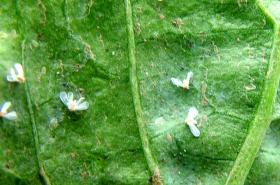
Whiteflies on chilli leaf. Adults are about 1mm long.
© B. Nyambo, A. A. Seif, icipe
Broad mite or yellow tea mite (Polyphagotarsonemus latus)
Broad mites are tiny (0.1-0.2 mm long) and cannot be seen with the naked eye, and are even difficult to detect with a hand lens. An attack by the broad mites can be detected by the symptoms of damage. They live on the underside of leaves, tender stems, fruits, flower peduncles and flowers. Their feeding produces discolouration, necrosis of tissues and deformation. Initial attack occurs on the stems of terminal shoots and the lower surface of young leaves.
Young leaves turn narrow, twisted or crumpled, fail to elongate and finally may wilt and dry, giving the plant a scorched appearance. Older leaves are generally cupped with corky brown areas between the main veins on the lower side of the leaves. The succulent part of the stem of young plants may become slightly swollen, roughened or russeted. The foliage becomes rigid. Attacked fruits become deformed with a cork-like surface or fail to develop. Severely infested fruits fall, and yield is significantly reduced. Symptoms remain for a long period of time after control.
- Broad mites are attacked by predacious mites. Phytoseiulus persimilisis not very much attracted to broad mites. Amblyseius spp are better predators of broad mites, in particular A. californicus is used for control of broad mites in different parts of the world.
- Broad mites can be effectively controlled with sulphur sprays. However, sulphur is toxic to predatory mites.
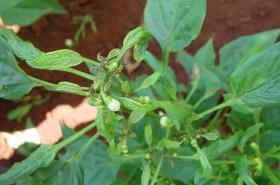
Broad mite (Polyphagotarsonemus latus) damage on chillies
© A.M. Varela, icipe
- Beije, C.M, Kanyagia, S.T., Muriuki, S.J.N., Otieno, E.A., Seif A.A., Whittle, A.M. (1984). Horticultural Crops Protection Handbook. National Horticultural Research Station.
- Black, L.L.,Green, S.K., Hartman, G.L., and Poulos, J.M. (1991). Pepper Diseases: A Field Guide. Asian Vegetable Research and Development Center, Taipei. ISBN: 92-9058-048-8.
- CABI. (2005). Crop Protection Compendium, 2005 Edition. © CAB International Publishing. Wallingford, UK. www.cabi.org
- East African Seed Co. Ltd. Africa's Best Grower's Guide www.easeed.com
- HCDA (1996). Chillies . Horticultural Crops Development Authority. Export Crop Bulletin: No 10, June 1996. Excerpted from the KEDS-Supported HCDA Export Crop Manual.
- Hill, D. S. (1983). Agricultural Insect pests of the tropics and their control. Second Edition. Cambridge University Press. pp 76. ISBN: 0 521 24638 5.
- Nutrition Data www.nutritiondata.com.
- Sherf, A.F., Macnab, A.A.(1986). Vegetable Diseases and Their Control. 2nd. Edition. John Wiley & Sons Inc. USA. ISBN: 0-471-05860-2